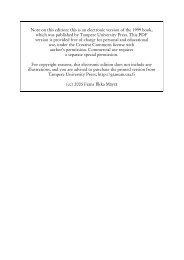Avaa tiedosto - TamPub - Tampereen yliopisto
Avaa tiedosto - TamPub - Tampereen yliopisto
Avaa tiedosto - TamPub - Tampereen yliopisto
You also want an ePaper? Increase the reach of your titles
YUMPU automatically turns print PDFs into web optimized ePapers that Google loves.
siveness of studies conducted on children and the expertise of those conducting them<br />
vary. When possible abuse is then dealt with in court in connection with child custody<br />
disputes, the threshold in the presentation of evidence is often high and it is possible that<br />
the risk of child sexual abuse is actually belittled.<br />
The analysed case documents demonstrate that the attitudes of professionals in social<br />
services and health care and judges vary between two standpoints that deviate from<br />
each other. From the “criticism of suspicion” point of view, suspicion of sexual abuse<br />
raised in child custody disputes can be suspected to be fabricated to serve a purpose. At<br />
the same time it might be emphasized how just a suspicion already hurts the accused<br />
parent and burdens the allegedly victimized child. From this point of view, the presented<br />
evidence of child sexual abuse is interpreted extremely scrupulously and called<br />
into question. When the situation is looked at from the ”concern for the child” perspective,<br />
it is emphasized that sexual abuse of children endangers and erodes seriously their<br />
possibilities to a safe life and balanced development. In this line of thinking, what is<br />
considered essential is careful examination of allegations and protection of the child if<br />
sexual abuse seems probable or possible.<br />
As professional helpers and authorities detect suspicions of sexual abuse in child<br />
custody disputes, these interpretation methods are immediately present. The “criticism<br />
of suspicion” and “concern for the child” perspectives are not directly divided according<br />
to occupational groups but are manifested in the views of social workers, child psychiatrists<br />
and judges. Sometimes professional differences can be detected; social workers,<br />
psychologists and child psychiatrists in their line of work underline the concern for the<br />
child and the judges in their interpretations criticism over suspicions of sexual abuse.<br />
When dealing with suspicions of child sexual abuse is compared to encountering<br />
physical violence against children and intimate partner violence in the different phases<br />
of child custody disputes, similarities can be found in them. Both sexual abuse and<br />
physical violence have to be proven to have an impact on decisions over child custody<br />
disputes. On the other hand, these are matters requiring evidence that is difficult to get<br />
and that varies in quality. Another significant combining factor is that maintaining the<br />
child’s relationship with the parent proven guilty of violence/sexual abuse is considered<br />
important despite the problems, and visits are allowed to be continued. Instead of being<br />
terminated, they are typically ordered to take place under supervision. Third, what is in<br />
common to the assessment of abuse and physical violence is the use of very careful and<br />
vague language. In fact, the words in assessments and conclusions concerning child<br />
sexual abuse are even more carefully chosen than in those concerning use of violence.<br />
268














